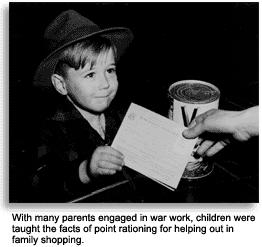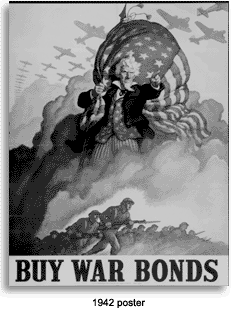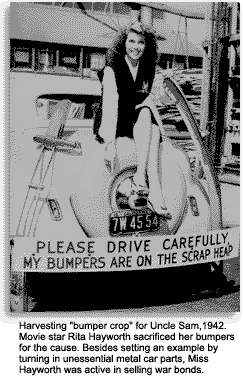With the onset of World War II, numerous challenges confronted the American people. The government found it necessary to ration food, gas, and even clothing during that time. Americans were asked to conserve on everything. With not a single person unaffected by the war, rationing meant sacrifices for all.
In the spring of 1942, the Food Rationing Program was set into motion. Rationing would deeply affect the American way of life for most. The federal government needed to control supply and demand. Rationing was introduced to avoid public anger with shortages and not to allow only the wealthy to purchase commodities.
 While industry and commerce were affected, individuals felt the effects more intensely. People were often required to give up many material goods, but there also was an increase in employment. Individual efforts evolved into clubs and organizations coming to terms with the immediate circumstances. Joining together to support and maintain supply levels for the troops abroad meant making daily adjustments. Their efforts also included scrap drives, taking factory jobs, goods donations and other similar projects to assist those on the front.
While industry and commerce were affected, individuals felt the effects more intensely. People were often required to give up many material goods, but there also was an increase in employment. Individual efforts evolved into clubs and organizations coming to terms with the immediate circumstances. Joining together to support and maintain supply levels for the troops abroad meant making daily adjustments. Their efforts also included scrap drives, taking factory jobs, goods donations and other similar projects to assist those on the front.
Government-sponsored ads, radio shows, posters and pamphlet campaigns urged the American people to comply. With a sense of urgency, the campaigns appealed to America to contribute by whatever means they had, without complaint. The propaganda was a highly effective tool in reaching the masses.
Rationing regulated the amount of commodities that consumers could obtain. Sugar rationing took effect in May 1943 with the distribution of "Sugar Buying Cards." Registration usually took place in local schools. Each family was asked to send only one member for registration and be prepared to describe all other family members. Coupons were distributed based on family size, and the coupon book allowed the holder to buy a specified amount. Possession of a coupon book did not guarantee that sugar would be available. Americans learned to utilize what they had during rationing time.
While some food items were scarce, others did not require rationing, and Americans adjusted accordingly. "Red Stamp" rationing covered all meats, butter, fat, and oils, and with some exceptions, cheese. Each person was allowed a certain amount of points weekly with expiration dates to consider. "Blue Stamp" rationing covered canned, bottled, frozen fruits and vegetables, plus juices and dry beans, and such processed foods as soups, baby food and ketchup. Ration stamps became a kind of currency with each family being issued a "War Ration Book." Each stamp authorized a purchase of rationed goods in the quantity and time designated, and the book guaranteed each family its fair share of goods made scarce, thanks to the war.
Rationing also was determined by a point system. Some grew weary of trying to figure out what coupon went with which item, or how many points they needed to purchase them, while some coupons did not require points at all.
In addition to food, rationing encompassed clothing, shoes, coffee, gasoline, tires, and fuel oil. With each coupon book came specifications and deadlines. Rationing locations were posted in public view. Rationing of gas and tires strongly depended on the distance to one's job. If one was fortunate enough to own an automobile and drive at the then specified speed of 35 mph, one might have a small amount of gas remaining at the end of the month to visit nearby relatives.
Rationing resulted in one serious side effect: the black market, where people could buy rationed items on the sly, but at higher prices. The practice provoked mixed reactions from those who banded together to conserve as instructed, as opposed to those who fed the black market's subversion and profiteering. For the most part, black marketeers dealt in clothing and liquor in Britain, and meat, sugar and gasoline in the United States.
 While life during the war meant daily sacrifice, few complained because they knew it was the men and women in uniform who were making the greater sacrifice. A poster released by the Office of War Information stated simply, “Do with less so they’ll have enough.” And yet another pleaded, “Be patriotic, sign your country’s pledge to save the food.” On the whole, the American people were united in their efforts.
While life during the war meant daily sacrifice, few complained because they knew it was the men and women in uniform who were making the greater sacrifice. A poster released by the Office of War Information stated simply, “Do with less so they’ll have enough.” And yet another pleaded, “Be patriotic, sign your country’s pledge to save the food.” On the whole, the American people were united in their efforts.
Recycling was born with the government’s encouragement. Saving aluminum cans meant more ammunition for the soldiers. Economizing initiatives seemed endless as Americans were urged to conserve and recycle metal, paper and rubber. War bonds and stamps were sold to provide war funds, and the American people also united through volunteerism. Communities joined together to hold scrap-iron drives, and schoolchildren pasted saving stamps into bond books.
Others planted "Victory Gardens" to conserve food. For a small investment in soil, seed and time, families could enjoy fresh vegetables for months. By 1945, an estimated 20 million victory gardens produced approximately 40 percent of America's vegetables.
Training sessions were held to teach women to shop wisely, conserve food and plan nutritious meals, as well as teach them how to can food items. The homemaker planned family meals within the set limits. The government's persuasion of people to give up large amounts of red meats and fats resulted in more healthy eating.
The government also printed a monthly meal-planning guide with recipes and a daily menu. Good Housekeeping magazine printed a special section for rationed foods in its 1943 cookbook. Numerous national publications also featured articles explaining what rationing meant to America.
 Then there were the food manufacturers who took advantage of the wartime shortages to flaunt their patriotism to their profit. The familiar blue box of Kraft Macaroni and Cheese Dinner gained great popularity as a substitute for meat and dairy products. Two boxes required only one rationing coupon, which resulted in 80 million boxes sold in 1943. Food substitutions became evident with real butter being replaced with Oleo margarine. Cottage cheese took on a new significance as a substitute for meat, with sales exploding from 110 million pounds in 1930 to 500 million pounds in 1944.
Then there were the food manufacturers who took advantage of the wartime shortages to flaunt their patriotism to their profit. The familiar blue box of Kraft Macaroni and Cheese Dinner gained great popularity as a substitute for meat and dairy products. Two boxes required only one rationing coupon, which resulted in 80 million boxes sold in 1943. Food substitutions became evident with real butter being replaced with Oleo margarine. Cottage cheese took on a new significance as a substitute for meat, with sales exploding from 110 million pounds in 1930 to 500 million pounds in 1944.
After three years of rationing, World War II came to a welcome end. Rationing, however, did not end until 1946. Life resumed as normal and the consumption of meat, butter, and sugar inevitably rose. While Americans still live with some of the results of World War II, rationing has not returned.